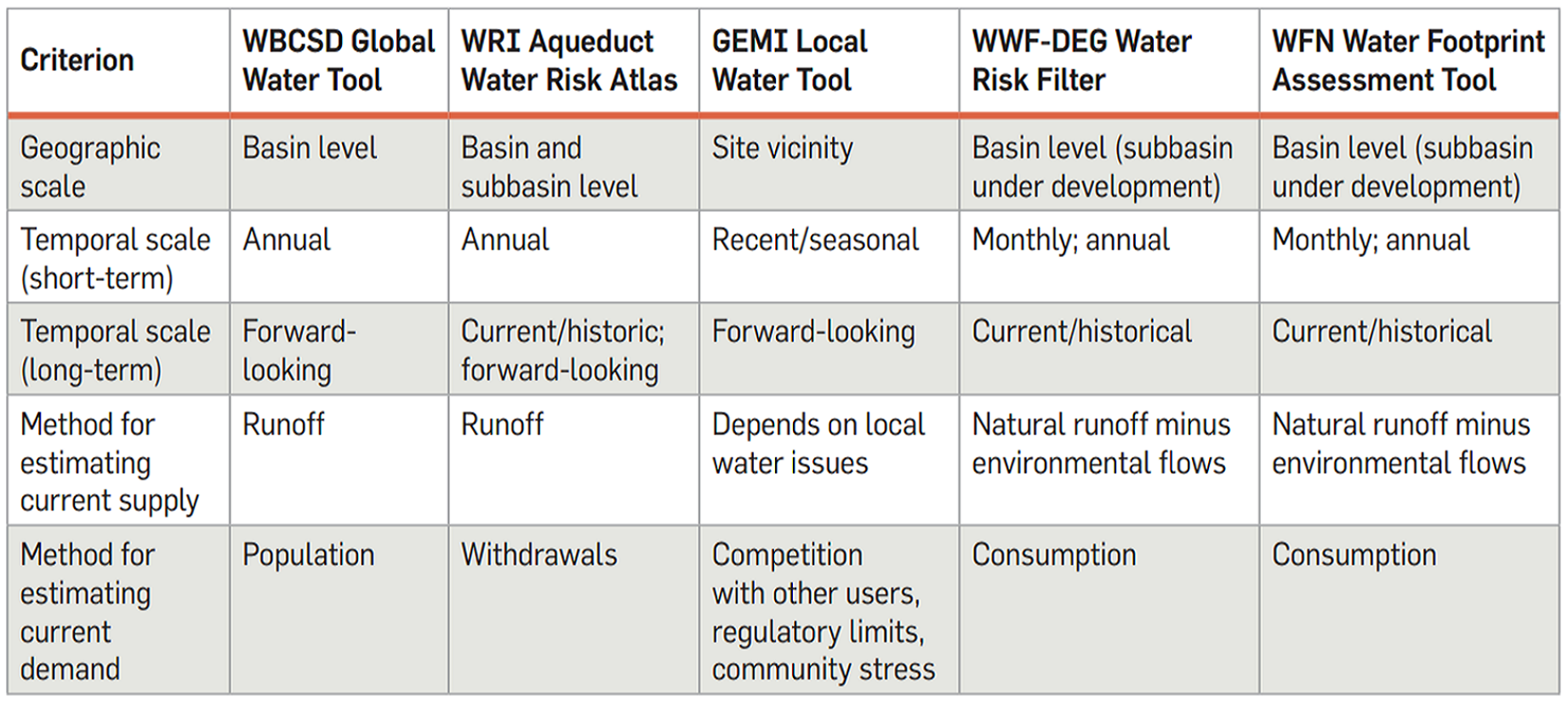Companies use a variety of tools to determine whether the catchments in which they operate are particularly exposed to water risk, as well as to better understand the nature of risk in specific catchments. The methods used to evaluate risk vary from tool to tool. While many of these tools use physical water scarcity as a proxy for risk, others consider both physical and economic water scarcity, while others still use an even broader set of criteria to evaluate risk. A few of these tools are listed below.
- The GEMI Local Water Tool™ (LWT) (http://www.gemi.org/localwatertool), developed by the Global Environmental Management Initiative (GEMI), is a free tool for companies and organizations to evaluate the external impacts, business risks, opportunities, and management plans related to water use and discharge at a specific site or operation. The GEMI LWT™ is meant to:
- Help companies assess external impacts, business risks, and opportunities; and manage water-related
issues at specific sites; - Provide a common and consistent visualization platform for internal and external communication;
- Provide interconnectivity between global and local water risk assessments, and a uniform
approach between site assessments; and - Provide a central repository of information for the individual user to create reports for internal
and external stakeholders.
- Help companies assess external impacts, business risks, and opportunities; and manage water-related
- The WBCSD Global Water Tool (GWT) (https://www.wbcsd.org/Programs/Food-and-Nature/Water/Resources/Global-Water-Tool) is a free online module that helps companies compare their water use, wastewater discharge, and facility information with validated watershed and country-level data (based on nearly 30 external datasets on water availability, sanitation, population, and biodiversity information, among other things). This process is intended to allow companies to conduct an initial high-level assessment of relative water risks in order to identify risk “hot spots.” This initial assessment is meant to be followed by more-detailed local assessments where appropriate.
- The Water Footprint Assessment (WFA) Tool (http://www.waterfootprint.org/?page=files/waterfootprintassessmenttool) is a free online application that helps users define their water footprint in a particular river basin or around a product, determine the impacts of that water footprint, and identify ways to reduce it. WFA assesses water scarcity based on blue water availability data in its WaterStat database. WFA is built around the Water Footprint Network’s water footprint indicator. Water footprints illustrate the volume of freshwater consumed and/or polluted to produce the goods and services consumed by an individual or community, or produced by a business.
- World Resources Institute’s (WRI) Aqueduct Tool (http://insights.wri.org/aqueduct/atlas) is a publicly available online global database of local-level water risk indicators and a global standard for measuring and reporting geographic water risk. It aims to inform public-private engagement on sustainable water management, facilitate smarter public and private investments on water technologies and infrastructure, and enable investors to better respond to differences in company exposure and water risk.
- The Water Risk Filter (http://waterriskfilter.panda.org), developed by World Wildlife Fund for Nature (WWF) in collaboration with the German development bank Deutsche Investitions- und Entwicklungsgesellschaft, is a free online tool that allows investors and companies from all industry sectors to assess and quantify water-related risks across the globe. The filter’s assessment is based on a company’s geographic location (for basin-related risks) and impact (for company-specific risks). The filter translates the most up-to-date underlying datasets, including the newest Water Footprint Network (WFN) scarcity data, into risk metrics. The results can be displayed on a companywide or portfolio level, as well as on a facility level.
The different approaches of the five tools mentioned above are summarized in the following table.

- Getting in Step: Engaging and Involving Stakeholders in Your Watershed, U.S. Environmental Protection
Agency, http://cfpub.epa.gov/npstbx/files/stakeholderguide.pdf - Multistakeholder Partnerships: Future Models of Multilateralism? Friedrich-Ebert-Stiftung, http://library.fes.de/pdf-files/iez/04244.pdf
- Understanding Public-Private Partnerships, United Nations Foundation, http://www.globalproblemsglobalsolutions-files.org/unf_website/PDF/understand_public_private_partner.pdf
- Integrated Water Resources Management: Guidelines for Stakeholder Participation in IWRM, Republic of South Africa’s Department of Water Affairs and Forestry, http://www.iwrm.co.za/resource doc/irwm 1/
Stakeholder Participation/Guidelines/GUIDELINES FOR STAKEHOLDER PARTICIPATION LEVEL 3.pdf

